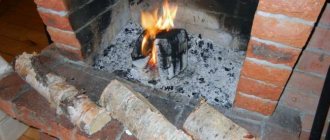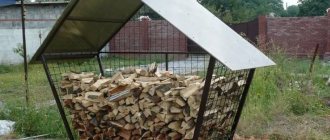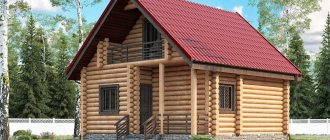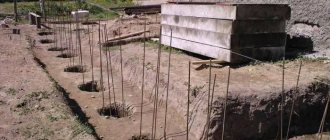Choosing the right cleaver and chopping wood is not as simple as it seems at first glance. When purchasing a tool, you need to consider what kind of wood you will be cutting, whether you have any experience in cutting, and what kind of cleaver to choose for comfortable work.
If you are planning to chop small logs, then an ordinary ax will do just fine; on large logs it will constantly get stuck. The cleaver has a less sharp sharpening angle, most often 40-60 degrees, and a longer handle than is suitable for working with large decks.
Difference from a regular ax
A splitting ax is much more convenient for chopping wood. It has a long handle (the so-called ax handle), the heavy blade is wedge-shaped, and its heavy weight and special shape promise to never get stuck in a wooden block.
The cleaver may look like a large hammer or sledgehammer with a pointed side, or it will be lighter and have protrusions-ears on both sides. Most often, the ax handle is made from birch, elm or maple wood.
Main characteristics
The cleaver is not an ax in the full sense, but it is directly related to it.
A hand tool has an ax handle on which a wedge-shaped working part (head) is mounted without sharp sharpening.
The cleaver is designed for a single blow, after which the log will split into pieces.
What is important here is not the sharpening of the blade, but the force of the blow.
Externally, the cleaver resembles more a sledgehammer than a classic axe.
One side of the head is flat (butt), and the opposite is wedge-shaped, made in the form of a double-sided cut at an angle of 40 - 50 degrees.
The weight of the cleaver reaches 5 kg, which allows it to cope even with large logs.
The meaning of this design lies not in cutting through the wood fibers, but in their delamination.
The thickness and length of the ax depends, first of all, on the size of the cleaver's head.
At the same time, the size of the handle directly affects the efficiency of work, since a long ax paired with a heavy head concentrates a decent impact force on a small area.
Blade
As already mentioned, the blade of the cleaver does not have a sharp edge.
Depending on the shape, wedge-shaped (wedge-shaped) and eared options are distinguished.
The second type, as the summer residents themselves note, is much inferior to the wedge-shaped ax in terms of ease of use.
It is noted that the head, due to the presence of “ears” set apart, often gets stuck in logs, after which it is difficult to remove.
The manufacturers themselves respond to this claim by saying that this design is designed to work with dry wood.
In reality, the owners of a private house use a tool to split raw, recently cut trunks, which is incorrect.
The piercing edge can be straight or rounded.
The first version of the cleaver is suitable for working with large dry logs.
The rounded blade has a larger size, which allows it to cope with resinous and damp wood.
The cleaver's head is made using the following methods:
• Stamping
Medium carbon steel is used.
In most cases, stamped cleavers weigh more than 2.5 kg, and their center of gravity is concentrated in the head. This allows you to use such a tool for working with large logs.
• Casting
The blade is made of hardened steel and is usually smaller in size compared to the option mentioned above.
They come in both straight and rounded.
Cast axes are more reminiscent of an axe.
Handle
The wooden ax handle is a classic.
It has always been used and will remain relevant for decades to come.
Unlike metal, wood has the beneficial property of absorbing shock and vibration.
In addition, wooden handles are relatively cheap and easy to manufacture.
All this affects the cost of the instrument for the better.
However, among the disadvantages it is worth noting the fact that the ax handle, if the technique of working with the cleaver is incorrect, splits.
An alternative to wood is fiberglass, a composite material with good strength properties.
Some models are produced with a rubberized handle, thereby increasing ease of use.
At the same time, it is lightweight, which allows you to shift the center of gravity of the instrument towards the head.
Fiberglass handle is a suitable solution for heavy cleavers.
Types of cleavers and their brief characteristics
Before you start work, you need to study all the options for axes and choose the most comfortable one. Firewood splitters can be of two types: mechanical and manual. It is better to use such a manual device only when you do not chop wood all the time, but only sometimes, rarely.
Handling a heavy tool is quite difficult and can even cause damage, so for continuous work, choose a mechanical cleaver. It can be of any size and weight and can handle any load. With such a device you will spend less energy, as you will need less dexterity and physical strength. Take what you like.
Mechanical splitting axes
Naturally, these devices are easier to work with. You can be offered two types of mechanical cleavers. The first is screw, the most common. Its main part is a steel cone with large threads.
Read here: How to choose an adjustable wrench - a review of the best tool sets and tips for choosing an adjustable wrench
Thanks to the rotating element, this thread seems to dig and go deep into the wood and easily splits it, even if the firewood is quite large.
The second option is hydraulic. It has more performance than the first one, but it is very difficult to make yourself. This cleaver instantly breaks the wood into the required sizes. It can run on electricity or gasoline, depending on the manufacturer, but it will cost more.
How to properly sharpen a carpenter's ax
There are two types of methods for sharpening an ax - manual and mechanized. Each of them, with a competent approach, is able to bring the instrument to perfection.
Bulgarian
The sparks emitted by the grinder are dangerous if the ax is sharpened by a person who is not protected by special clothing and glasses. This method, although fast, is not effective, since heating the metal worsens the performance characteristics of the ax.
On sandpaper
You can sharpen an ax on emery only after making sure that the grinding wheel is free of defects. Next, mark the corner to be cut with a marker. After this, fix the tool and turn the grinding wheel. Sharpening is completed when the surface marked with a marker on the blade is completely erased.
On the grinding machine
Ideal chamfer parameters and a neat edge can only be achieved on a sharpening machine. Doing this is easier than doing it manually. However, the continuity of this process leads to overheating of the metal part. High temperatures destroy structural bonds in metal molecules and lead to deterioration in strength characteristics.
File
To manually sharpen an ax with a file, you need to secure it in a vice and place the file at the desired angle to the top of the tooth. This operation must be done on both sides.
Choosing a hand cleaver
And yet many people wonder: how to choose a cleaver? How can you be confident in your choice and not regret it in the future? The following nuances will help you with this. Look at the cutting part - the best are forged, cast, and steel is well heat-treated.
Do you want to determine metal quality? Click on it with your finger. The sound after the click should become clear, but if it is dull, firmly move on. If you are a beginner, take a cleaver with a wooden handle, and if you are already experienced, take a look at the sample with a fiberglass axe. It is stronger and more durable.
The length and shape of the handle is at your discretion, rely on the sensations when you hold the ax in your hands and swing, because you will have to swing more than once. And it is also worth considering that it is better to give preference to Finnish, Russian, German and Swedish companies for the production of cleavers.
Be careful not to fall for a fake. If splitting firewood is at a high level, then buy strong devices from the best companies, and for home purposes, simple splitting splitters made by yourself are also suitable.
How to chop wood correctly?
Despite the apparent simplicity of the process, you need to know how to chop wood correctly so as not to become physically overtired and not to injure yourself or others. In addition, the type of logs that come out from under your ax will determine how well and how long they will burn.
Process description
To make the job easier, follow the following procedure:
Chipping of the edges of a thick log
- Place the block of wood on the deck so that the knots or most of them remain at the bottom.
- Find a crack , which almost always exists at the end of a sawn log, and turn it so that the blow of the cleaver hits it.
- If there are no cracks, try to get an ax or cleaver between the knots or along them. When chopping wood with an ax, it can get stuck in a log, hitting a knot. In this case, the ax along with the log must be turned with the butt down and struck with force against the deck.
- It is more convenient to chop very thick blocks not in the middle, but by splitting the blocks closer to the edge.
Tip: you don’t need to put in a lot of force when lowering the cleaver onto the log. Just lift it above your head and lower it with acceleration - the weight of the cleaver itself is enough for it to do its job.
Safety precautions
- To prevent the ax from flying off the handle, the day before chopping wood, lower it into a container of water. The ax handle will swell and the ax will sit firmly on it.
- While working, spread your legs wide : this is both convenient and will protect you from accidental mistakes.
- Make sure that there are no people nearby, especially children , since when cutting firewood can fly quite far in different directions.
What should the logs be like?
If you do not want the firewood to burn too quickly or not to burn completely, leaving firewood, then the thickness of the logs should be 7–10 centimeters. How to split wood so that it turns out exactly like this?
It depends on the thickness of the logs. Thin ones are split in half into two blocks, and then each block is split in half again, obtaining the so-called quadrangles.
Wood splitting scheme
Thick logs will have to be split into octagons, that is, each quadrangle will have to be halved. If you come across very thick logs, then split each octagon in half, but not along the radius, but across it, so that two smaller logs are formed: one triangular, the second tetrahedral.
Blocks (halves of a log) can be split not into two, but into three triangular parts (or two triangular and one tetrahedral) to obtain logs of the required thickness - sixes.
Tip: it’s easiest to split firewood when it’s dry, but it’s better to split damp firewood if it’s been left in the cold. If there is no urgent need, do not rush to chop freshly sawed raw logs - let them dry or lie under a canopy until winter.
How to store firewood?
You should not put firewood in a woodpile (see DIY woodpile) immediately after cutting it. If the weather is sunny, dry, let them lie in the open air in a heap, even if the logs were initially dry. If the weather turns bad, they need to be covered with a tarpaulin, or it is better to immediately lay the pile under a canopy so that unexpected rain does not take you by surprise.
Firewood stacked in a neat woodpile can sit for several years without loss of quality. If the firewood was very fresh when chopping, then it is best to start using it after a year.
We hope that our tips will help you chop firewood quickly without getting overtired. When you start chopping wood for the first time, don’t try to immediately set a quantitative record. Otherwise, you may wake up the next day with sore muscles and bloody calluses on your palms.
Homemade cleavers
Due to the simple designs, you can make axes with your own hands. Why do it, you ask, when you can buy it? It's more economical.
It will be more profitable to make this instrument from available means than to spend a lot of money on its purchase, especially when your finances are not that big.










